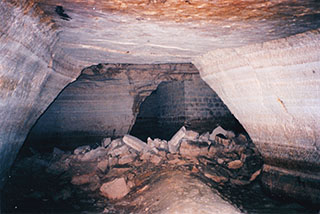Prochain point : lat="49.1321" lon="2.04911"

Gypsum quarries
The toponymy recalls the exploitation of the quarries
From gypsum to plaster…
The geological formations in Grisy-les-Plâtres are mainly the outcome of the Tertiary era, which spanned from 65 to 2.6 million years ago. The different layers are made of sand, limestone, clay and marl. However, Grisy-les-Plâtres is mainly known for gypsum or “plaster”. The sediments were formed between 37 and 33 million years ago. The quarries ran from the Early Middle Ages (8th – 11th centuries) until the early 20th century.
Following extraction, the gypsum is slowly fired between 150 and 200 degrees so that the water evaporates. Once it has cooled, the rock is ground to a powder, which when added to water, becomes the plaster. It was used to make sarcophagi in the Merovingian age, and later as plaster or mortar for dwellings. In the 20th century, its use for outside plastering slowly decreased in favour of production of gypsum plasterboards and planks.
… A royal edict
In 1777, following serious accidents caused by the collapse of the underground quarries, Louis XVI decided to create a special team of engineers responsible for inspecting the quarries. On 19 July 1784, a royal edict for the town of Grisy ordered works for filling cavities, reshaping of embankments and eviction of residents whose houses were in danger. In order to prevent accidents and cave-ins, it was decided that oper





